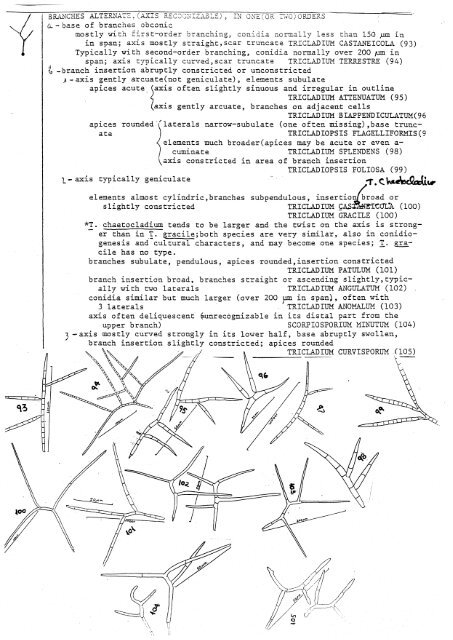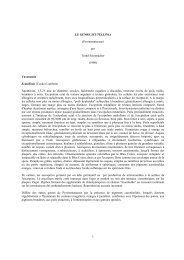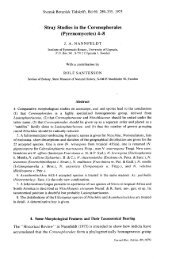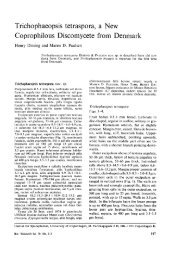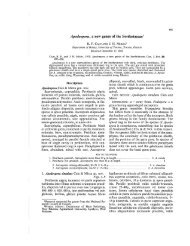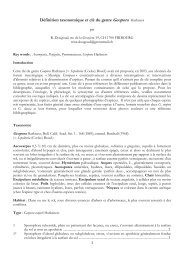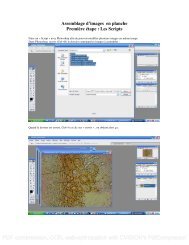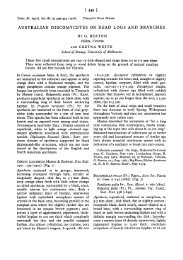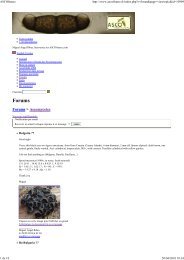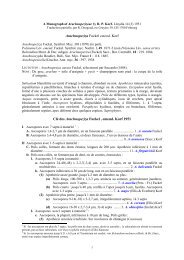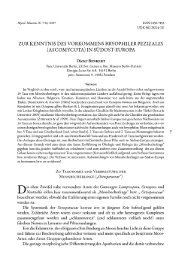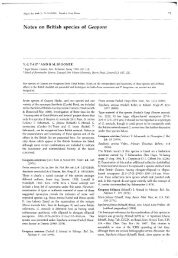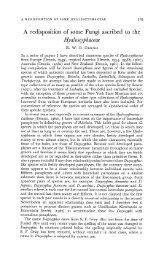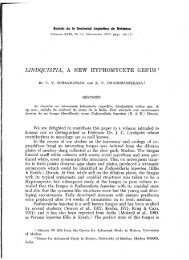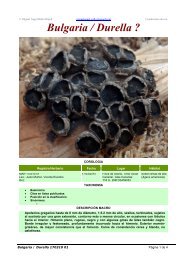Aquatic Hyphomycetes Descals et. al. - ASCOfrance
Aquatic Hyphomycetes Descals et. al. - ASCOfrance
Aquatic Hyphomycetes Descals et. al. - ASCOfrance
Create successful ePaper yourself
Turn your PDF publications into a flip-book with our unique Google optimized e-Paper software.
BRANCHES ALTERNATE, (AXIS RECOGNIZABLE), IN ONE (OR TWQjORDERS ; 7 : ~<br />
Gu-base of branches obconic<br />
mostly with first-order branching, conidia norm<strong>al</strong>ly less than 150 jam in<br />
in span; axis mostly straight, scar truncate TRICLADIUM CASTANEICOLA (93)<br />
Typic<strong>al</strong>ly with second-order branching, conidia norm<strong>al</strong>ly over 200 pm in<br />
span; axis typic<strong>al</strong>ly curved,scar truncate TRICLADIUM TERRESTRE (94)<br />
t -branch insertion abruptly constricted or unconstricted<br />
ji - axis gently arcuate(not geniculate), elements subulate<br />
apices acute (axis often slightly sinuous and irregular in outline<br />
'< TRICLADIUM ATTENUATUM (95)<br />
(axis gently arcuate, branches on adjacent cells<br />
TRICLADIUM BIAPPENDICULATUM(96<br />
apices rounded flater<strong>al</strong>s narrow-subulate (one often missing),base truncate<br />
] TRICLADIOPSIS FLAGELLIFORMIS(9<br />
elements much broader (apices may be acute or even acuminate<br />
TRICLADIUM SPLENDENS (98)<br />
'^axis constricted in area of branch insertion<br />
TRICLADIOPSIS FOLIOSA (99)<br />
t-axis typic<strong>al</strong>ly geniculate TaCU^eficfcUi**<br />
elements <strong>al</strong>most cylindric,branches subpendulous, insertion/broad or<br />
slightly constricted TRICLADIUM CAsB^ETCOUk (100)<br />
TRICLADIUM GRACILE (100)<br />
*T. cha<strong>et</strong>ocladium tends to be larger and the twist on the axis is stronger<br />
than in T. gracile;both species are very similar, <strong>al</strong>so in conidiogenesis<br />
and cultur<strong>al</strong> characters, and may become one species; T. gracile<br />
has no type.<br />
branches subulate, pendulous, apices rounded,insertion constricted<br />
TRICLADIUM PATULUM (101)<br />
branch insertion broad, branches straight or ascending slightly,typic<strong>al</strong>ly<br />
with two later<strong>al</strong>s TRICLADIUM ANGULATUM (102) .<br />
conidia similar but much larger (over 200 urn in span), often with<br />
3 later<strong>al</strong>s • ' TRICLADIUM ANOMALUM (103)<br />
axis often deliquescent ^unrecognizable in its dist<strong>al</strong> part from the<br />
upper branch) SCORP 10SPORIUM MINUTUM (104)<br />
-* —axis mostly curved strongly in its lower h<strong>al</strong>f, base abruptly swollen,<br />
branch insertion slightly constricted; apices rounded<br />
TRICLADIUM CURVISPORUM (105)


